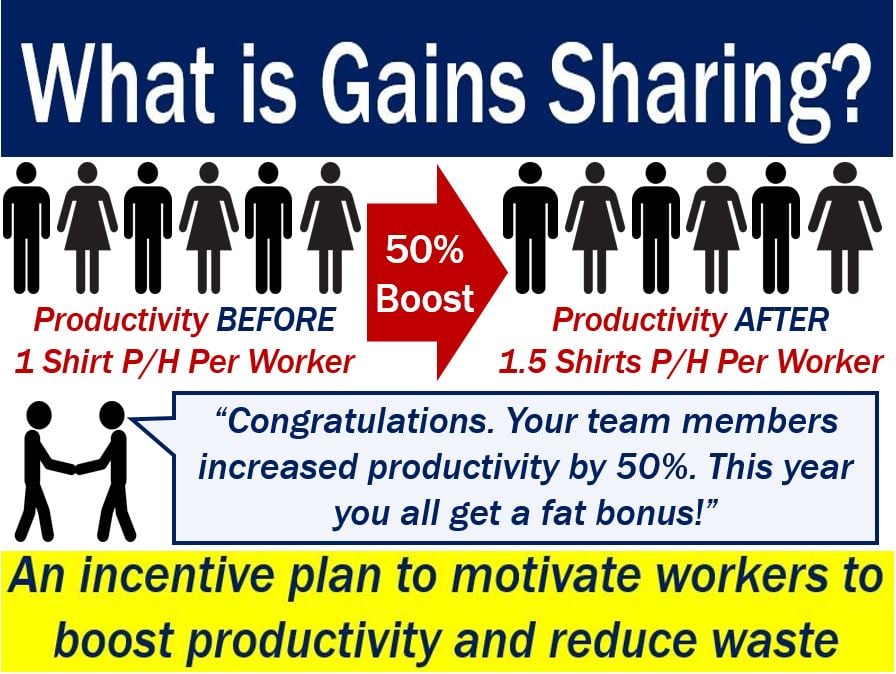Gains sharing, gainsharing, gain share, or gainshare is a system businesses use to try to get their employees to become more productive. It is a management system to increase profitability by motivating workers to boost their performance through participation and involvement. As their productivity increases, so do the company’s profits. Workers subsequently share financially in the improvement.
Productivity refers to how much each worker produces over a given period. In other words, production per worker per hour.
Gains sharing, however, does not result in substantial improvements if management does not participate closely.
Gains sharing vs. profit sharing
Do not confuse the term with profit sharing. Although the aims behind both systems are similar, their means are not the same.
In a profit-sharing system, workers receive bonuses which go up or down depending on the company’s profits. In other words, the bigger the profits, the bigger the bonus for each worker.
Employees also earn bonuses in a gains sharing system. However, each worker’s performance determines the size of those bonuses.

For example, employees’ productivity or sales volumes may determine their bonuses. Whether or not they managed to reduce expenses may also be a determining factor.
Both systems aim to give workers a share in the success of their employer. However, with gains sharing, their bonuses are more closely related to their individual performances.
In fact, in a gains sharing program, it is possible for a worker to receive a bonus even when the company registers a loss. Of course, they would only get their bonus their own performance had improved.
This is not possible in a profit-sharing system. In a profit-sharing scheme, what matters is whether the company made a profit, and how big it was.
Gains sharing dates back to 1930s
In the 1930s, MIT lecturer Joe Scanlon, a labor leader, said that workers had significantly more to offer than simply a pair of hands. In other words, workers were not mere drones in a manual labor market.
Prof. Scanlon argued that the best and simplest solution was in the hands of the person closest to a problem. Additionally, any solution was more likely to work if you involved that worker.
To help a company that was in trouble, Prof. Scanlon and the business’ owner asked its workers for their ideas. Specifically, their ideas on how to lower costs and reduce waste.
By using worker input, they managed to make significant improvements, and the company became much more successful.
Other companies subsequently asked Prof. Scanlon to help them. These were companies that had barely survived the Great Depression.
Prof. Scanlon eventually became the Acting Director of the Steelworkers Research Department. He used his skills to create joint labor/management improvement committees to help make the military more effective during WWII.
Gains sharing now
Companies today use gains sharing to measure worker performance, and also to reward them when it improves.
Most employers use a pre-determined formula to share the savings with all workers.
A company’s gains sharing goals depend on the business’ long-term competitive strategy. They also depend on its cost structure.
It is important to tailor each program to fit the industry, i.e., service, manufacturing, etc.
In a gains sharing system, employees share in the benefits. Subsequently, they develop more of a sense of ownership for their company and their work.
Additionally, the system gives workers a better understanding of how they influence their employer’s success. It also helps workers better understand why a company is failing and what measures it must take.
